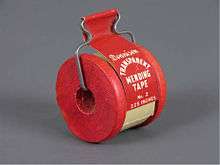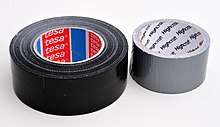Adhesive tape
Adhesive tape refers to any one of a variety of combinations of backing materials coated with an adhesive. Different backing materials and adhesives can be used depending on the intended use.
History
Pressure-sensitive adhesive (PSA), a key component of some adhesive tapes, was first developed in 1845 by Dr. Horace Day, a surgeon.[1] In 1901, the German Oscar Troplowitz invented an adhesive patch called Leukoplast for the German company Beiersdorf AG. In 1936, German company Beiersdorf AG invented a transparent adhesive patch called Tesa.[2]
Types
Pressure-sensitive tape

Pressure-sensitive tape, PSA tape, self-stick tape or sticky tape consists of a pressure-sensitive adhesive coated onto a backing material such as paper, plastic film, cloth, or metal foil. It is sticky (tacky) without any heat or solvent for activation and adheres with light pressure. These tapes usually require a release agent on their backing or a release liner to cover the adhesive. Sometimes, the term "adhesive tape" is used for these tapes.
Many pressure-sensitive adhesive tapes exhibit triboluminescence, observable in a dark room, when peeled off a dispenser roll or other surface.[3][4]
Dependence of adhesive strength on the shape
The adhesiveness of the tape does depend not only on the type of the tape but also on its macroscopic shape. Tapes with sharp corners start to detach at pointed corners[5]. The adhesive strength can be sufficiently improved by cutting the edges as shown in the film[6]
Water activated tape
Water activated tape, gummed paper tape or gummed tape is starch- or sometimes animal glue-based adhesive on a kraft paper backing which becomes sticky when moistened.
A specific type of gummed tape is called reinforced gummed tape (RGT). The backing of this reinforced tape consists of two layers of paper with a cross-pattern of fiberglass filaments laminated between. The laminating adhesive had previously been asphalt but now is more commonly a hot-melt atactic polypropylene.
Gummed tapes are described in ASTM D5749-01(2006)[7] Standard Specification for Reinforced and Plain gummed Tape for Sealing and Securing.
Water-activated tape is used for closing and sealing boxes. Before closing corrugated fiberboard boxes, the tape is wetted or remoistened, activated by water. The tape is mostly 3 inches (7.5 cm) wide.
Heat sensitive tape
Heat activated tape is usually tack-free until it is activated by a heat source. It is sometimes used in packaging, for example, a tear strip tape for cigarette packs. Conversely, thermal release tape, such as REVALPHA by Nitto Denko, loses its tack and fully releases when heated to a certain temperature. This type of tape is used often in the semiconductor industry.
Drywall tape
Drywall tape is paper, cloth, or mesh, sometimes with a gummed or pressure-sensitive adhesive. It is used to make the joints between sheets of drywall materials.[8]
See also
References
- ↑ Journal of the American Institute for Conservation, By Merrily A. Smith, Norvell M. M. Jones, II, Susan L. Page and Marian Peck Dirda;JAIC 1984, Volume 23, Number 2, Article 3 (pp. 101 to 113)
- ↑ Tesa.de: Geschichte (German)
- ↑ "Archived copy" (PDF). Archived from the original (PDF) on 2013-05-12. Retrieved 2013-04-10.
- ↑ "Pages · Towson University". towson.edu. Archived from the original on 2013-04-05.
- ↑ Popov, Valentin L.; Pohrt, Roman; Li, Qiang (2017-09-01). "Strength of adhesive contacts: Influence of contact geometry and material gradients". Friction. 5 (3): 308–325. doi:10.1007/s40544-017-0177-3. ISSN 2223-7690.
- ↑ Friction Physics (2017-12-06), Science friction: Adhesion of complex shapes, retrieved 2018-01-02
- ↑ "ASTM D5749 - 01(2012) Standard Specification for Reinforced and Plain Gummed Tape for Sealing and Securing". www.astm.org. Archived from the original on 2017-02-04. Retrieved 2017-02-02.
- ↑ Hedstrom, Gary (2005). How to Fix Everything for Dummies. For Dummies. p. 81. ISBN 0-7645-7209-1.
External links
| Wikimedia Commons has media related to Adhesive tapes. |
